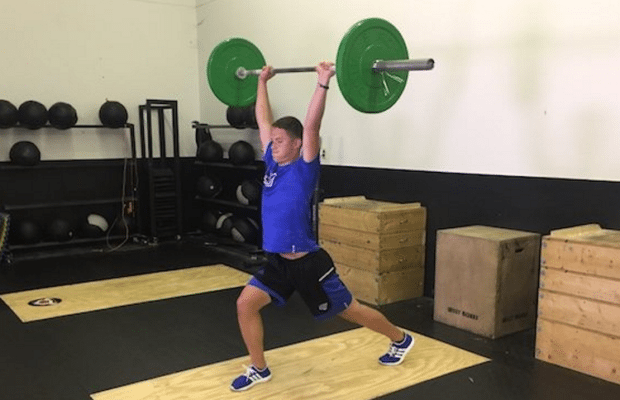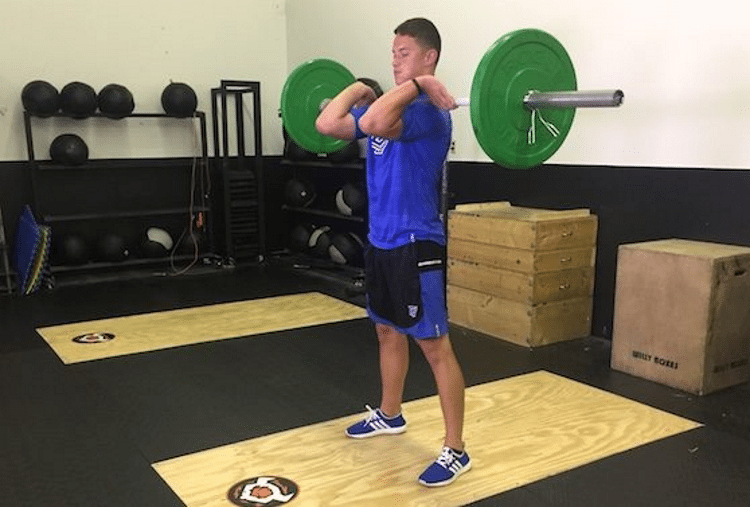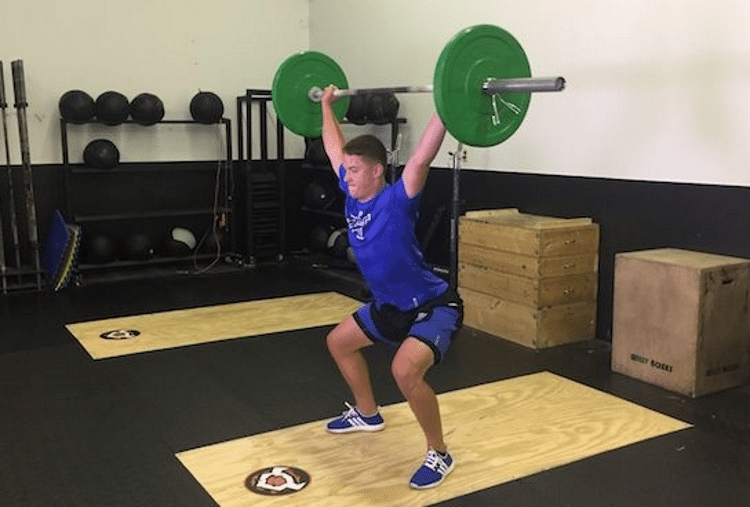How to Properly Use Olympic Lifting to Improve Sports Performance

There’s a good chance you will come across Olympic lifts in your training program in your athletic career—especially if you’re a football player or wrestler. Olympic lifts after all are considered one of, if not the, most effective type of exercises for developing explosive power, a critical ingredient for becoming a better athlete.
If you’re not familiar, Olympic lifts refer to exercises that are based on the Snatch and Clean and Jerk, which are the only two exercises performed at the Olympic games. You can see examples of athletes competing in the Snatch and Clean and Jerk here and here.
However, Olympic lifts are complicated exercises. The technique needed to correctly perform them is arguably more complex than any other lift. You also need to know the right way to use Olympic lifts in your workouts, or you run the risk of wasting your time or hurting yourself.
So we listed out the do’s and don’ts of Olympic lifts to help you safely take advantage of these exercises.
Do practice your form before using weight
Olympic lifts are the only individual exercises that athletes compete in at the Olympics—hence the name. These athletes spend thousands of hours perfecting their form to move unbelievable amounts of weight with incredible explosive power.
As an athlete who competes in football, hockey, wrestling or any other sport, you simply don’t have the time and resources to master Olympic lifting form like Olympic athletes. It would be equivalent to telling a hockey player who has never played football to learn how to throw a football at an elite level. Not gonna happen.
The point we are trying to make is: Olympic lifts are challenging and shouldn’t be taken lightly. Performing them incorrectly will not only severely limit how much weight you can lift, but is a recipe for a serious injury if you’re not careful.
Before attempting Olympic lifts with even a barbell, you should practice the lifts with a broomstick or PVC pipe. Ask a strength coach for help or if you don’t have access to a strength coach, check out our detailed resources on the primary O-lifts with instruction from Anderson.
Once you master your form, progress to a barbell and then begin adding weight. Remember, slow and steady wins the race.
Don’t use just any barbell
Yes, the type of barbell you use matters a lot. Most barbells in gyms are what you can call beater bars. These are low-quality bars that are often slightly bent and even rusted, making it difficult to perform an Olympic lift with correct form.
In an ideal situation, you should always use a bar designed for Olympic lifting. This type of bar has a light knurling (or grip) so your hands don’t get torn up. It also has collars that spin well so the bar can rotate independently of the weights as you transition to the catch position.
Do Olympic lifts at the beginning of a workout
To actually get more powerful with Olympic lifts—and to do them correctly—your muscles need to be fresh. That way you can move with maximum explosiveness to lift the heavy bar at high speeds.
The best—and really only—time to perform Olympic lifts is at the beginning of your workout, after a full dynamic warm-up. Performing them after strength work or other strenuous exercises will limit how much you can lift and impair your technique, which as we discussed above is a major no-no when it comes to Olympic lifts.
Don’t perform too many sets and reps
You must follow the quality-over-quantity rule when it comes to Olympic lifts—and in fact, most other exercises. That means fewer quality reps are superior to a higher quantity of subpar reps where your form will inevitably get sloppy.
According to Anderson, most athletes will have success performing about 3-5 sets of 1-3 reps—no more than 5 reps. Advanced athletes who have years of Olympic lifting experience under the belt may do even more sets of single reps so they can lift the maximal amount of weight possible.
High-rep Olympic lifts have become increasingly popular thanks to CrossFit. This style of lifting is extremely challenging and will test your conditioning and toughness. However, it’s meant to create highly conditioned CrossFit athletes. If you want to increase your explosive power, there’s no substitute for low-rep O-lifts. There’s nothing inherently wrong about high-rep Olympic lifts if your goal is conditioning—assuming you use proper form—but you need to understand the difference.
Do rest between sets
Taking a break between your sets allows you to maintain rep quality in the subsequent sets—you’re probably starting to sense a theme here.
Plan to take about 2-3 minutes of rest between sets to allow your muscles to sufficiently recover. If you have a particularly tough set or plan to hit a new PR, you can bump this time up to five minutes. Yes, it might sound boring, but resting is essential. If you need something to do, take this time to review your workout chart or work on your mobility.
Don’t use a weight that’s too heavy
If you lift weights, you probably grind out slow reps here and there, which is perfectly fine for strength training. However, this won’t fly for Olympic lifts, where speed is far more important than how much weight you can lift.
A weight that’s too heavy will result in one of two scenarios: 1) your form will be ugly, or 2) you will miss the rep altogether. So air on the side of lighter weight, even when performing sets with a single rep. You can begin to challenge yourself a bit more as you become more advanced.
If you don’t know where to start, performance coach Wil Fleming has an excellent guide on how to properly load Olympic lifts.
Do Find Variations That Work for You
There’s nothing that says you have to do a specific Olympic lift—unless you have an adamant coach. Maybe you have trouble with the catch on the Clean or can’t even do an Overhead Press without arching your lower back, nevertheless do a Snatch.
If you’re not comfortable with or are still learning the more complex variations, opt for easier alternatives such as the Clean Pull or Push Press. These exercises offer similar benefits, will actually improve your form and are relatively easy to perform.
Are those exercises still intimidating? Check out these alternatives to O-lifts that don’t even involve a barbell.
Read the original article in Stack.com by Andy Haley.
Andy Haley is the Performance Director at STACK, and has been with the Company for over seven years. A certified strength and conditioning specialist (CSCS) through the NSCA, he’s worked with hundreds of elite performance experts to create articles and videos to educate STACK’s audience with safe and effective performance training methods. Prior to STACK, he received his bachelor’s degree in exercise science from Miami University (Oxford, Ohio), where he conducted research on resistance training and physical activity for the American College of Sports Medicine. Born and raised outside of Boston, Haley played hockey at the collegiate club level. His favorite exercise is the Deadlift.

